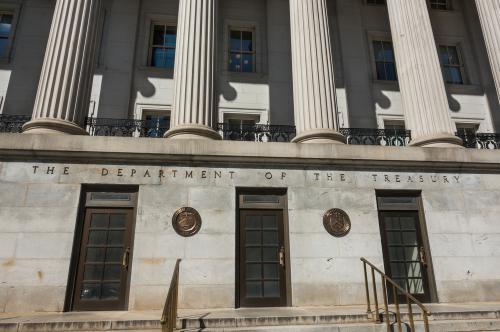What’s the latest thinking in fiscal and monetary policy? The Hutchins Roundup keeps you informed of the latest research, charts, and speeches. Want to receive the Hutchins Roundup as an email? Sign up here to get it in your inbox every Thursday.
Immigration lowers the share of US elderly in institutions by making home care more affordable
Immigration allows more U.S. elderly to age outside institutions by lowering the cost of home-based care, find Kristin F. Butcher of Wellesley, Kelsey Moran of MIT, and Tara Watson of Williams College. The authors show that a 10-percentage point increase in the less educated, foreign-born share of the local labor force lowers the probability of institutionalization of individuals over 65 and 80 by 26% and 29%, respectively. Had immigration remained at 1980 levels, their estimates imply, the average over-65 American in 2000 would have been 10% more likely to live in an institution. Immigration makes labor-intensive home care both more affordable and more available, the authors say: higher immigration rates lower wages for less-educated workers and increase employment of health and nursing aides, as well as other home-support workers like housekeepers and gardeners. In contrast, wages for highly trained workers like registered nurses — more likely to work in institutional settings — increase, and their hours worked fall.
Democrats lost support in the 1990s due to NAFTA
Jiwon Choi of Princeton and co-authors find that U.S. counties that were more exposed to import competition from Mexico as a result of the 1994 North American Free Trade Agreement (NAFTA) suffered employment declines and, as a result, became less supportive of Democrats. Specifically, NAFTA-exposed counties historically voted Democrat in House and Presidential elections but began to lean Republican in the early- to mid-1990s, and voted majority-Republican by 2000. Using election survey data for the U.S., the authors find that the majority of voters with protectionist views shifted from identifying as Democrats in the 1986-1992 period to identifying as Republican from 1992 onwards. The shift was especially pronounced for white men, those without a college degree, and those with conservative social views. The heterogeneous response to the trade agreement suggests “an interactive effect whereby racial identity and social-issue positions mediate reactions to economic policies,” the authors conclude.
Households of color face higher constraints when searching for rental properties
Using fictitious inquiries in over 25,000 interactions with rental property managers across the 50 largest U.S. cities and using first and last name combinations that signal race, Peter Christensen from the University of Illinois at Urbana-Champaign, Christopher Timmins from Duke, and Ignacio Sarmiento-Barbieri from the University of Los Andes find that households of color face discrimination when searching for rental properties in most U.S. markets. Inquiries sent from white renters receive an average response rate of 60% while inquiries sent from Black and Latinx renters were 5.6 and 2.8 percentage points lower. However, the authors note that “overall differences in response rates mask important variation between and within regions of the United States.” They show that the strongest discriminatory constraints facing African Americans are in Chicago, Los Angeles, and Louisville, and for Latinx renters, they are in Louisville, Houston, and Providence. Stronger discriminatory constraints — particularly for Black renters — are strongly associated with higher levels of residential segregation and larger gaps in intergenerational income mobility.
Chart of the week: American household spending on goods is well above pre-pandemic levels, not so spending on services
Source: The Wall Street Journal
Quote of the week:
“I think the word ‘transitory’ has different meanings to different people. To many, it carries a time — a sense of short-lived. We tend to use it to mean that it won’t leave a permanent mark in the form of higher inflation. I think it’s probably a good time to retire that word and try to explain more clearly what we mean … [T]he most recent data, particularly since the November FOMC [Federal Open Market Committee] meeting show elevated inflation pressures, a rapid improvement in many labor market indicators without an accompanying addition of labor supply. And also, strong spending that really signals big, significant growth in coming months,” says Jerome Powell, Chair of the Federal Reserve Board.
“Remember that every dollar of asset purchases actually adds accommodation to the economy. But at this point, the economy is very strong and inflationary pressures are high and it is therefore appropriate in my view to consider wrapping up the taper of our asset purchases — which we actually announced at the November meeting — perhaps a few months sooner. And I expect that we will discuss that at our upcoming meeting in a couple of weeks. Of course, between now and then we will see another labor market report, another inflation report. And we’ll also get a better sense of the new COVID variant as well before we make that decision.”
The Brookings Institution is financed through the support of a diverse array of foundations, corporations, governments, individuals, as well as an endowment. A list of donors can be found in our annual reports published online here. The findings, interpretations, and conclusions in this report are solely those of its author(s) and are not influenced by any donation.
The Brookings Institution is committed to quality, independence, and impact.
We are supported by a diverse array of funders. In line with our values and policies, each Brookings publication represents the sole views of its author(s).








Commentary
Hutchins Roundup: Immigrant labor, NAFTA, and more
December 2, 2021